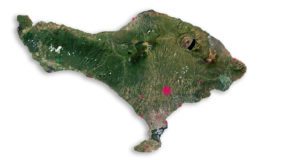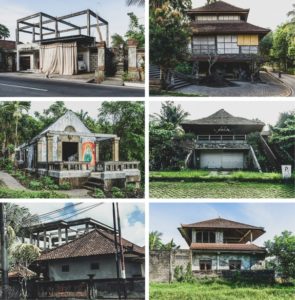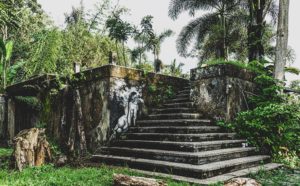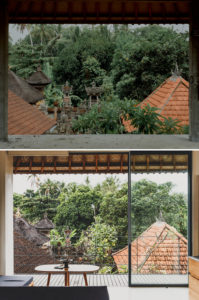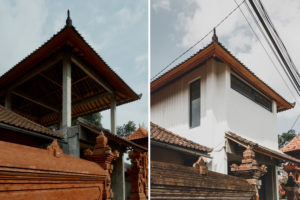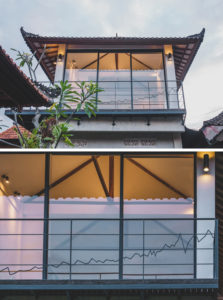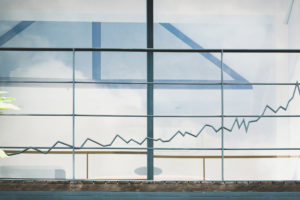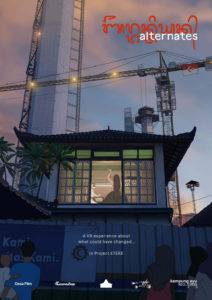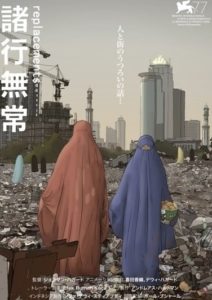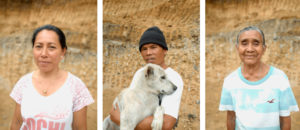Project Etere [PE] is an experimental and collaborative architectural project trying to connect and integrate the fields of real estate development, social impact, design, contemporary art and economics. The initiative was launched in Bali in 2019, with the aim of formulating an alternative architectural development model based on careful observation of a specific urban fabric and its relationship with the social and cultural context. The cause that triggered the start of PE’s creative process was the increasing urbanisation of the island due to the rapid increase in mass tourism. In recent decades, through globalisation and international travel, Bali has emerged as one of the world’s leading tourist destinations, but this shift from elite to mass tourism has generated an island-wide phenomenon of self-employment, with countless citizens – Balinese, Indonesians and foreigners – building properties and businesses to meet the growing demands of the new flow of tourists. This has given rise to the problem addressed by Project Etere, namely the absence of a proper town plan on the island. This controversy has created a growing urban problem: a large number of buildings have been constructed without considering the context and without continuity, to the point that many structures have been abandoned, left incomplete or in disuse. This urban decay has ‘stained’ the Balinese landscape, which has ended up being dotted with these ‘ghost’ buildings that have remained inactive for months or even years, due to insufficient funding, poor budget management or funds set aside to give priority to other concerns, such as religious activities, often considered a priority in Balinese culture. Project Etere was launched to respond to this delicate urban situation and, to counterbalance it, is proposing a new model of real estate development engaged with both architectural and social issues. A process of mapping and scouting for potential project sites that could be the subject of a rebirth continues to this day thanks to this initiative, which, thanks to a collective commitment, leads these places to ‘rise’ as innovative, artistic and community platforms. The first example of this project is Contemporary Artisanal Studio Apartment [PE#1], the first prototype PE in Ubud, Bali.
Map of Bali, ‘ghost’ buildings. Courtesy of Project Etere.
‘Ghost’ buildings. Courtesy of Project Etere.
The birth of the project
It is mainly thanks to Marco Cassani, artist and Rebirth/Third Paradise ambassador, and a team of creatives that the initiative was developed: “This project,” says Cassani, “was the brainchild of Ran Ben-Shaya, an Israeli architect who came to Bali for an internship at an architecture studio in Ubud. The idea developed later, with the meeting that Shaya had with Indonesian designer Eva Natasa, one of the guests at the forum ‘Sustainability Through Differences’, which I organised in 2018. When I heard about this beautiful project, I saw a new possible partner to collaborate with for my social sculptures through the lens of Kayu, reflecting on the concept of art as a tool to socialise and re-evaluate the territory, the population and society in general. I invited Shaya to participate in the ‘VISIBLE AWARD GOAL’ event at the Batu Art Space, an art space I had founded with my artist colleague Fendry Ekel in Bali – click here for info –, and on the occasion we proposed a streaming conference with the project Visible Award. Inspired by the proposals of Visible, we decided to develop Project Etere in the Balinese territory, starting from where we live, Ubud”. Cassani, through his project Kayu – Lucie Fontain, thus began to collaborate with Project Etere, together with Eva Natasa and Ran Ben-Shaya, becoming responsible for the artistic part.
PE, before and after. Photo by Chris Bunjamin and Evelyn Pritt.
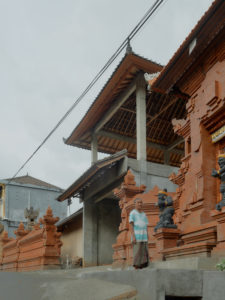
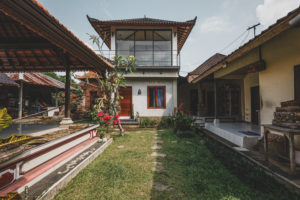
PE, view from the outside. Photo by Chris Bunjamin.
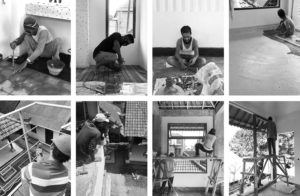
PE, work in progress. Courtesy Project Etere
Its use
Cassani highlights the possibilities offered by the spaces acquired by Project Etere: “We can host artistic residencies that allow the participants to be fully immersed in our reality. In fact, we are committed to ensuring that the project can turn each space into an active and sustainable platform, where workshops and activities can also be organised. We do not want any property to become a simple flat, but a useful place linked to a specific context”. One of the objectives is to develop the initiative in other places: “This first project in Ubud is a prototype,” Cassani specifies, “but our idea is to expand: we have already mapped a number of abandoned buildings, and we will be able to collaborate with the owners of abandoned houses and breathe new life into the structures we have identified”. In order to achieve overall sustainability, the project cannot neglect the economic aspect: “It is essential,” he points out, “that we can create a local economy based on ethics and responsibility. An example? The Balinese family that owns the space that PE rented for ten years and that has become the Contemporary Artisanal Studio Apartment [PE#1], PE’s first project, had an abandoned property within their family compound that they couldn’t finish or make active; by renting the unfinished and abandoned building for ten years and paying in advance, Shaya and Natasa gave the Balinese family the opportunity for an instant economic benefit. Furthermore, by intervening on the existing structure and completing the building according to the principles of sustainability, social impact and craftsmanship, PE gave new life to the space through an approach that involved art, design, tradition and innovation. That building has now become an accommodation facility that anyone can rent (for a day or a year) through travel agencies both local and online, such as Booking.com and Airbnb, and has given Shaya and Natasa the opportunity to hire the building’s owner part time and offer her a job managing the new space. In addition to this, PE will return the artistically and economically developed property to the Balinese owner at the end of the lease”.
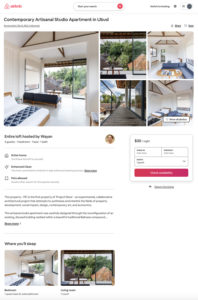
PE on Airbnb.

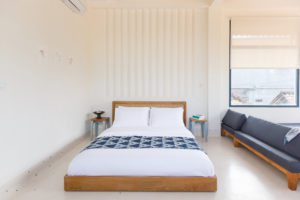
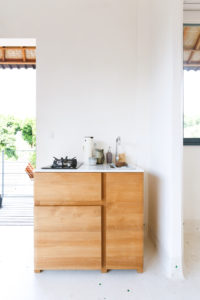

PE, internal spaces. Photo by Evelyn Pritt
Collaborations
What has mainly given the project its social imprint is the contamination of the work team, which has seen the contribution of different professionals and experts. Cassani, for example, invited Canadian artist Terence Gower – whose artistic practice reflects on the relationship between contemporary art and architecture – to collaborate on the first PE project in Kayu – Lucie Fontaine’s programme called Domesticity: “He was so pleasantly surprised by our project,” Cassani revealed, “that he decided to participate in the construction of the property by designing the building’s railing and the spiral staircase of the Contemporary Artisanal Studio Apartment [PE#1]. Subsequently fabricated by Project Etere, Gower’s artwork, along with three of his drawings, was on display during the exhibition ‘Domesticity VIII’ that I curated at PE#1 and is still available to tenants renting the flat”. The aesthetic of the work was conceived as a display of data on Balinese tourism from the years 1975 to 2025: the railing, in fact, appears as if it were a graph, divided into vertical bars representing the various years and horizontal ones referring to the number of tourists who have visited the island; the graph of the last five years, from 2020 to 2025, will be installed at the end of 2025 and will reflect the most recent tourist development figures for the area. Another ongoing collaboration, which is proving invaluable to the initiative, is with French-Indonesian artist Jonathan Hagard, who lives in Kyoto, Japan, internationally known for directing the animated film (his first) called Replacements, which has won many awards and was selected for the Venice Biennale of Cinema. The film is a VR animation video taking the viewer into a village that is slowly transformed into a city.
PE, artistic intervention on spiral staircase and railing. Courtesy Kayu – Lucie Fontaine and Project Etere. Photo by Evelyn Pritt.
“The reference,” Cassani specifies, “is to the urban, environmental, political and cultural transformations that the island of Java in Indonesia underwent from 1980 to 2020. During this change, many of the island’s roots and traditions disappeared to make way for Muslim megalopolises. The film shows the transition of a simple village into a chaotic city of supermarkets, mosques and huge buildings. Since this film is about environmental change and the cultural transformation of a specific reality, it seemed perfect to invite my fellow artist Hagard to interact with Project Etere”. Hagard will be the first artist to participate in the residency programme: during the period from March to April this year he will stay at PE#1 to make a new film inspired by the project. Called Alternates, the film will tell of an alternative Bali, hypothesising what the island might be like if the Balinese had not performed the famous ritual of mass suicide, in protest at the invasion by Dutch settlers at the beginning of the twentieth century, which helped the Balinese to preserve their culture and traditions. Cassani says: “The film presents a parallel reality in order to understand how Balinese culture would have evolved if the settlers had introduced Islamic worship, as it happened on the island of Java. The film will then be permanently installed at PE#1 and will be available to the public during the period of the exhibition and, later, to the tenants during their stay in the flat”.
Poster of Alternates, courtesy of the artist and Kayu – Lucie Fontaine; poster of Replacements, courtesy of the artist.
Poster of Alternates, courtesy of the artist and Kayu – Lucie Fontaine; poster of Replacements, courtesy of the artist.
Art for social rebirth
All the pieces of the puzzle were finally together: after a meeting between the Project Etere representatives and the owner, works started in the flat that has become the Contemporary Artisanal Studio Apartment [PE#1], which had been in a state of disrepair for more than five years. Shava and Natasa, after outlining the prospects of their initiative together with Cassani, rented the second floor of the house for ten years. The project team thus began to study the layout and design the flat together with the owner, always respecting the surrounding architecture, as required by the regulations, and the need to preserve Balinese culture. All the materials used are in fact local, from either Bali itself or the island of Java. “In addition to Gower’s artistic intervention mentioned above, I made sure to include contemporary art in the context of the project. Through my social sculptures in the form of exhibitions and performances by my fellow artists,” concluded Cassani, “I would like to bring contemporary art into unconventional social contexts and closer to the uninitiated, trying to create new cultural dialogues; in particular, with Project Etere as a new partner in Kayu – Lucie Fontaine, I have the opportunity to reflect on the theme of the domestic through a series of site-specific exhibitions, which investigate its relationship with the notion of intimacy but also as a dynamic field of social and collective change”.

